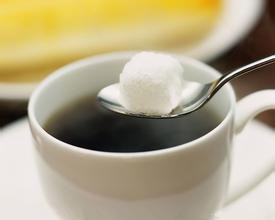Basic knowledge of fine coffee knowledge of small-grain coffee

Coffee (scientific name: Coffea arabica), also known as coffee tree, Arabica coffee, etc., is the national flower of Yemen. Before the 6th century in the park, Yemen was called Arab, so the coffee trees transported from them to other places were also called Arabian coffee trees. The name coffee comes from the Arabic word "Qahwah", which means plant drink. Later, coffee spread all over the world and was named after its place of origin, "Kaffa". It was not officially named "coffee" until the 18th century.
Coffee knowledge
It is an evergreen shrub of Rubiaceae in plant taxonomy. Lateral branches extend horizontally, opposite, occasionally three whorls; simple leaves opposite, flowers are 2-10 clumps in leaf axils, the fruit is drupe oval, the first fruit is dark green, yellowish red or purplish red when ripe, the fruit of coffee is formed by pericarp, pulp, endocarp, silver peel, and the seeds (coffee beans) wrapped in the innermost layers mentioned above, the seeds are located in the central part of the fruit, and the parts outside the seeds are of little use.
The world's first coffee tree was found in the Horn of Africa. Coffee cultivation began in the 15th century. For hundreds of years, Yemen in the Arabian Peninsula is the only coffee producer in the world, and the market demand for coffee is very strong. In the Yemeni port of Moka, when coffee is shipped out, it often needs to be protected by heavy troops. At the same time, Yemen has also taken various measures to prevent coffee saplings from being taken out of the country. Despite many restrictions, Muslim pilgrims on the pilgrimage to the holy city of Mecca secretly brought coffee saplings back to their hometown, so coffee soon took root in India. At that time, in Venice, Italy, countless merchant ships traded perfumes, tea, leaves and textiles with merchants from Arabia. In this way, coffee spread to a wide area of Europe through Venice. Many European businessmen have become accustomed to drinking coffee. Later, small vendors peddling coffee appeared on the streets of many European cities, and coffee gained rapid popularity in Europe. In the 17th century, the Dutch introduced coffee to their colony of Indonesia. At the same time, the French began to grow coffee in Africa. Today, coffee has become the second largest trading product on the earth after oil! Among the countless legends of coffee discoveries, there are two legends that people are most interested in talking about, namely, the Story of the Shepherd and the Arab Monk.
Three major coffee growing areas in the world: Africa, Indonesia and Central and South America. Yemen is the first country in the world to produce coffee on a large scale as a crop. The method of cultivation and treatment of mocha coffee in Yemen today is basically the same as that of hundreds of years ago. On most coffee farms in Yemen, coffee farmers still resist the use of artificial chemicals such as chemical fertilizers. Coffee farmers plant poplars to provide shade for coffee to grow. Coffee trees are planted on steep terraces to maximize the use of less rainfall and limited land resources. Yemeni mocha beans are still shipped in a bag made of straw, unlike chemical woven bags in other places.
Yemeni coffee has been cultivated for more than 2000 years. According to statistics, coffee is cultivated in 76 countries in the world. Coffee in China was first introduced in Taiwan in 1884. In 1908, overseas Chinese brought back large and medium seeds from Malaysia to Hainan Island. At present, the main cultivation areas are Yunnan, Guangxi, Guangdong and Hainan.
Small grains of coffee
[scientific name]
The small seed is Coffea arabica L., the medium grain is Coffea canephora, and the large grain is Coffea liberica.
Family and genus: coffee genus of Rubiaceae
[alias]
Small seed species are also called Arabian species, medium seed species are also called Ganfla species, and large seed species are also called Liberian species.
There are two kinds of common: Arabica and Robusta.
Coffee is rich in protein, fat, sucrose, starch, caffeine and other substances. after being made into a beverage, coffee is rich in aroma, delicious taste and rich nutrition, so it has become the world's three major beverages composed of tea and cocoa, and ranks first in the list. Yunnan coffee is a variant of Arabian original species, which has been cultivated for more than one hundred years after long-term cultivation and domestication.
Morphological features: small trees or large shrubs, plant height 5-8 meters. Base usually much branched, old branches gray-white. Nodes inflated, young branches glabrous. Leaves thinly leathery-ovate-lanceolate or lanceolate, apex long acuminate, base cuneate or slightly obtuse, entire or shallowly wavy, both surfaces glabrous. Cymes several clustered in leaf axils, Corolla white, fragrant. When ripe, berries are broadly oval, red, 1.2 × 1.6 cm long, and seeds 0.8-1.0 cm long. The florescence is from March to April.
Origin and distribution: originated in Ethiopia or Arabian Peninsula. It is cultivated in Fujian, Taiwan, Guangdong, Hainan, Guangxi, Sichuan, Guizhou and Yunnan.
The main ingredients of coffee
Caffeine: it has a particularly strong bitter taste and stimulates the central nervous system, heart and respiratory system. Appropriate amount of caffeine can also reduce muscle fatigue and promote digestive juice secretion. Because it promotes kidney function, it is diuretic and helps the body to expel excess sodium ions from the body. But eating too much can lead to caffeine poisoning.
Tannic acid: the boiled tannic acid will decompose into pyrouric acid, so the coffee that has been brewed for too long will taste worse.
Fat: the most important ones are acid fat and volatile fat.
Acidic fat: that is, fat contains acid, its strength will vary according to the type of coffee.
Volatile fat: is the main source of coffee aroma, it is a kind of aroma will emit about 40 kinds of aromatic substances.
Protein: the main source of calories, the proportion is not high. Most of the protein in coffee powder will not dissolve out when brewing coffee, so the intake is limited.
Sugar: coffee beans contain about 8% sugar. After baking, most of the sugars are converted to caramel, which browns the coffee and combines with tannins to produce sweetness.
Fiber: the fiber of raw beans will be carbonized after baking and combine with caramel to form the hue of coffee.
Minerals: contains a small amount of lime, iron, phosphorus, sodium carbonate and so on.
Table of nutritional components of coffee
Every 100 grams of coffee beans contain 2.2 grams of water, 12.6 grams of protein, 16 grams of fat, 46.7 grams of sugar, 9 grams of cellulose, 4.2 grams of ash, 120 milligrams of calcium, 170 milligrams of phosphorus, 42 milligrams of iron, 3 milligrams of sodium, 0.12 grams of vitamin B2, 3.5 milligrams of nicotinic acid, 1.3 grams of caffeine and 8 grams of tannins. Every 100 grams of coffee extract contains 99.5 grams of water, 0.2 grams of protein, 0.1 grams of fat, 0.1 grams of ash, trace sugars, 3 mg of calcium, 4 mg of phosphorus, 2 mg of sodium, 0.01 mg of vitamin B2 and 0.3 mg of nicotinic acid. Dissolve 10 grams of coffee in hot water with 0.04 grams of caffeine and 0.06 grams of tannins.
Important Notice :
前街咖啡 FrontStreet Coffee has moved to new addredd:
FrontStreet Coffee Address: 315,Donghua East Road,GuangZhou
Tel:020 38364473
- Prev

Coffee enema is suitable for people who do intestinal detoxification.
Bowel cancer is a high incidence of cancer. 75% of the body's detoxification is accomplished through defecation. Constipation will produce stools and produce a large amount of toxins in the body, which will lead to the occurrence of bowel cancer. Hunan Satellite TV's Encyclopedia said that it brings us a new method of large intestine detoxification. At present, colorectal detoxification is listed as an alternative therapy in Europe and the United States. Suitable for people who do intestinal detoxification: 1. Constipation, poor defecation or
- Next

Who was the first to find coffee? The Arab chieftain discovered coffee for the first time
In 1258, Sheikh Omar, who was deported by his people for crime, was exhausted and hungry when he wandered to Vasaba (in Arabia). When he sat under the tree to rest, he saw a bird coming, pecking at the fruit on the branch, and then jumped up and down happily and tore his throat open to sing. The chief has never heard of such a wonderful bird.
Related
- Beginners will see the "Coffee pull flower" guide!
- What is the difference between ice blog purified milk and ordinary milk coffee?
- Why is the Philippines the largest producer of crops in Liberia?
- For coffee extraction, should the fine powder be retained?
- How does extracted espresso fill pressed powder? How much strength does it take to press the powder?
- How to make jasmine cold extract coffee? Is the jasmine + latte good?
- Will this little toy really make the coffee taste better? How does Lily Drip affect coffee extraction?
- Will the action of slapping the filter cup also affect coffee extraction?
- What's the difference between powder-to-water ratio and powder-to-liquid ratio?
- What is the Ethiopian local species? What does it have to do with Heirloom native species?

